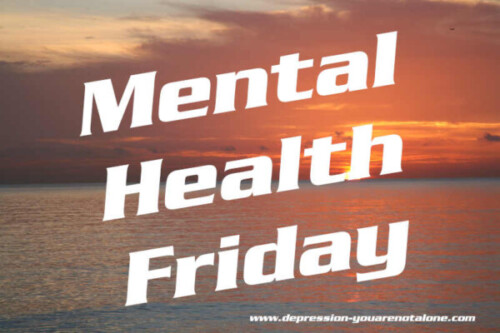Mental Health Friday 2023-06-16
On Mental Health Friday, we post, in alphabetical order, one per week, information on mental health disorders. Mental Health Friday is for informational purposes only, and is in no way meant to diagnose, treat or cure any disease. Please do not self diagnose and seek professional help for what ails you.
Link: FindTreatment.gov is an online source of information for persons seeking substance use and/or mental health treatment facilities in the United States or U.S. Territories.
Mania
By Editorial Team
Mania is a complex psychological condition characterized by an elevated or irritable mood, increased energy levels, and an abundance of activity and goal-directed behavior. It is a key feature of bipolar disorder, specifically bipolar I disorder, and can also occur in other psychiatric conditions such as schizoaffective disorder and substance-induced mood disorder.
Here, we’ll discuss various aspects of mania, including its symptoms, causes, diagnostic criteria, associated features, and treatment options.
- Symptoms of Mania:
- Elevated mood: Individuals experiencing mania often feel an intense euphoria, an exaggerated sense of well-being, or extreme happiness. They may appear excessively cheerful, enthusiastic, or optimistic.
- Increased energy: Manic individuals display heightened levels of energy, often engaging in multiple activities simultaneously. They may feel restless and have a reduced need for sleep.
- Rapid speech: Manic individuals often talk rapidly, jumping from one topic to another, and may have difficulty maintaining a coherent conversation.
- Racing thoughts: Thoughts may race through their minds, making it challenging to concentrate or focus on a particular task.
- Impulsivity: Mania can lead to impulsive behavior, such as reckless spending, engaging in risky activities, or making hasty decisions without considering potential consequences.
- Grandiosity: Individuals in a manic episode may have an inflated sense of self-importance, believing they possess special powers or abilities. They may make unrealistic plans or have delusions of grandeur.
- Increased sociability: Manic individuals may become excessively sociable, seeking out social interactions, initiating conversations with strangers, and displaying overly familiar behavior.
- Reduced inhibition: They may exhibit a diminished sense of social restraint, engaging in behaviors that are normally considered inappropriate or out of character.
- Causes of Mania:
- Biological factors: Mania is believed to have a genetic component, as it often runs in families. Neurotransmitter imbalances, particularly involving dopamine and norepinephrine, are also implicated in the development of mania.
- Environmental factors: Stressful life events, significant life changes, or disruptions in sleep patterns can contribute to the onset of manic episodes. Substance abuse or certain medications, such as antidepressants or stimulants, can also trigger mania.
- Diagnostic Criteria: The Diagnostic and Statistical Manual of Mental Disorders (DSM-5) outlines specific criteria for diagnosing a manic episode. These criteria include a distinct period of abnormally and persistently elevated, expansive, or irritable mood lasting at least one week (or any duration if hospitalization is required). During this period, three or more of the following symptoms should be present:
- Increased self-esteem or grandiosity
- Decreased need for sleep
- More talkative than usual or pressure to keep talking
- Flight of ideas or racing thoughts
- Distractibility
- Increase in goal-directed activity or psychomotor agitation
- Excessive involvement in pleasurable activities with a high potential for negative consequences
- Associated Features:
- Hypomania: Hypomania refers to a less severe form of mania. It shares similar symptoms but has a shorter duration and less impact on daily functioning. Hypomanic episodes are characteristic of bipolar II disorder.
- Mixed episodes: Some individuals with bipolar disorder experience mixed episodes, where symptoms of mania and depression occur simultaneously or rapidly alternate. This can lead to intense emotional turmoil and increased risk of self-harm.
- Psychosis: In severe cases, mania can be accompanied by psychotic symptoms, such as hallucinations (perceiving things that aren’t there) or delusions (firmly held false beliefs).
- Treatment Options:
- Medication: Mood stabilizers, such as lithium or anticonvulsant medications, are commonly prescribed to manage mania. Antipsychotic medications may be used in conjunction with mood stabilizers to control symptoms, especially during severe episodes or when psychosis is present.
- Psychotherapy: Various forms of therapy, including cognitive-behavioral therapy (CBT) and psychoeducation, can help individuals with mania understand their condition, manage symptoms, and develop coping strategies.
- Lifestyle adjustments: Maintaining a regular sleep schedule, avoiding stressors, and engaging in stress-reducing activities like exercise or relaxation techniques can help stabilize mood.
- Social support: Having a strong support system, including family, friends, and support groups, can provide emotional assistance and practical help during manic episodes.
In conclusion, mania is a multifaceted condition characterized by elevated mood, increased energy levels, impulsivity, and a range of other symptoms. It can significantly impact an individual’s life and relationships. Proper diagnosis, understanding of the causes, and appropriate treatment, including medication and therapy, are crucial in managing mania and preventing its potential negative consequences.

